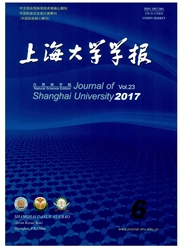

 中文摘要:
中文摘要:
Metallothioneins(MTs) are normally considered to be sensitive indicators of heavy metal pollution, but it is less clear whether the MT gene can actively respond to other environmental stresses. In this study, an MT m RNA molecular sequence of 471 bp(full length) was identified in marine cultured black porgy(Acanthopagrus schlegelii), encoding 60 amino acids containing 20 cysteine residues. The MT sequence was highly homologous to that of other fish belonging to the MT superfamily type 1 family. The three dimensional structure of the deduced MT peptide was composed of two metal-binding domains capable of ligating divalent heavy metals. The MT m RNA transcripts were detected in the 11 tested tissues and the highest quantity was present in the liver. Stresses by two factors, benzo[a]pyrene(B[a]p) exposure and bacterial challenge, were evaluated on MT gene expression. The level of MT gene transcripts in the liver significantly declined 24 h post B[a]p exposure and the quantity was significantly correlated with the exposure time during a 24 h period. In contrast, MT gene expression in the liver was significantly increased 48 h post bacterial infection and the quantity was significantly correlated with the infection time during this period of 48 h. Our results indicated that MT gene expression in black porgy liver was sensitive to environmental stresses other than just the heavy metal pollution reported, suggesting that the development of a reliable biomarker for heavy metal pollution will be more complex than expected.
 英文摘要:
英文摘要:
Metallothioneins (MTs) are normally considered to be sensitive indicators of heavy metal pollution, but it is less clear whether the MT gene can actively respond to other environmental stresses. In this study, an MT mRNA molecular sequence of 471 bp (full length) was identified in marine cultured black porgy (Acanthopagrus schlegelii), encoding 60 amino acids containing 20 cysteine residues. The MT sequence was highly homologous to that of other fish belonging to the MT superfamily type 1 family. The three dimensional structure of the deduced MT peptide was composed of two metal-binding domains capable of ligating divalent heavy metals. The MT mRNA transcripts were detected in the 11 tested tissues and the highest quantity was present in the liver. Stresses by two factors, benzo[a]pyrene (B[a]p) exposure and bacterial challenge, were evaluated on MT gene expression. The level of MT gene transcripts in the liver significantly declined 24 h post B[a]p exposure and the quantity was significantly correlated with the exposure time during a 24 h period. In contrast, MT gene expression in the liver was significantly increased 48 h post bacterial infection and the quantity was significantly correlated with the infection time during this period of 48 h. Our results indicated that MT gene expression in black porgy liver was sensitive to environmental stresses other than just the heavy metal pollution reported, suggesting that the development of a reliable biomarker for heavy metal pollution will be more complex than expected.
 同期刊论文项目
同期刊论文项目
 同项目期刊论文
同项目期刊论文
 Preparation of NaLuF4:Gd, Yb, Tm-TiO2 nanocomposite with high catalytic activity for solar light ass
Preparation of NaLuF4:Gd, Yb, Tm-TiO2 nanocomposite with high catalytic activity for solar light ass Caseinophosphopeptides cytoprotect human gastric epithelium cells against the injury induced by zinc
Caseinophosphopeptides cytoprotect human gastric epithelium cells against the injury induced by zinc Polybrominated diphenyl ethers in surface sediments from principal watersheds of Shanghai, China: le
Polybrominated diphenyl ethers in surface sediments from principal watersheds of Shanghai, China: le Radiolytic degradation and mechanism study of electron beam-irradiated solutions of 4-tert-octylphen
Radiolytic degradation and mechanism study of electron beam-irradiated solutions of 4-tert-octylphen The Photodegradation of Clopyralid in Aqueous Solutions: Effects of Light Sources and Water Constitu
The Photodegradation of Clopyralid in Aqueous Solutions: Effects of Light Sources and Water Constitu Organochlorine pesticides in fish from Taihu Lake, China, and associated human health risk assessmen
Organochlorine pesticides in fish from Taihu Lake, China, and associated human health risk assessmen C-axis preferentially oriented and fully activated TiO2 nanotube arrays for lithium ion batteries an
C-axis preferentially oriented and fully activated TiO2 nanotube arrays for lithium ion batteries an Growth inhibition and coordinated physiological regulation of zebrafish (Danio rerio) embryos upon s
Growth inhibition and coordinated physiological regulation of zebrafish (Danio rerio) embryos upon s Enhancing upconversion luminescence of NaYF4: Yb/Er nanocrystals by Mo3+ doping and their applicatio
Enhancing upconversion luminescence of NaYF4: Yb/Er nanocrystals by Mo3+ doping and their applicatio Airborne PM2.5/PM10-Associated Chlorinated Polycyclic Aromatic Hydrocarbons and their Parent Compoun
Airborne PM2.5/PM10-Associated Chlorinated Polycyclic Aromatic Hydrocarbons and their Parent Compoun Synthesis of NaLuF4-based nanocrystals and large enhancement of upconversion luminescence of NaLuF4:
Synthesis of NaLuF4-based nanocrystals and large enhancement of upconversion luminescence of NaLuF4: Enhancing the performance of front-illuminated dye-sensitized solar cells with highly [001] oriented
Enhancing the performance of front-illuminated dye-sensitized solar cells with highly [001] oriented Regulation of metallothionein gene expression in response to benzo[a]pyrene exposure and bacterial c
Regulation of metallothionein gene expression in response to benzo[a]pyrene exposure and bacterial c Aquatic photolysis of florfenicol and thiamphenicol under direct UV irradiation, UV/H2O2 and UV/Fe(I
Aquatic photolysis of florfenicol and thiamphenicol under direct UV irradiation, UV/H2O2 and UV/Fe(I 期刊信息
期刊信息
